Nike's Outsourcing Strategy: A Detailed Analysis of Decision-Making
VerifiedAdded on 2023/05/28
|10
|1970
|131
Report
AI Summary
This report provides an in-depth analysis of Nike's outsourcing decisions, exploring the internal and external factors that led to the company's offshore manufacturing strategy. It includes a literature review on outsourcing, examining various viewpoints and discussing the long-term impacts on Nike's profit, reputation, and sales. The report also proposes strategies for enhancing sales and quality through effective outsourcing practices, such as selecting the right activities, considering all costs, choosing the right partners, and maintaining control over outsourced components. The study concludes that outsourcing, when implemented strategically, can significantly contribute to a company's competitive advantage and overall success. Desklib provides access to similar solved assignments and resources for students.
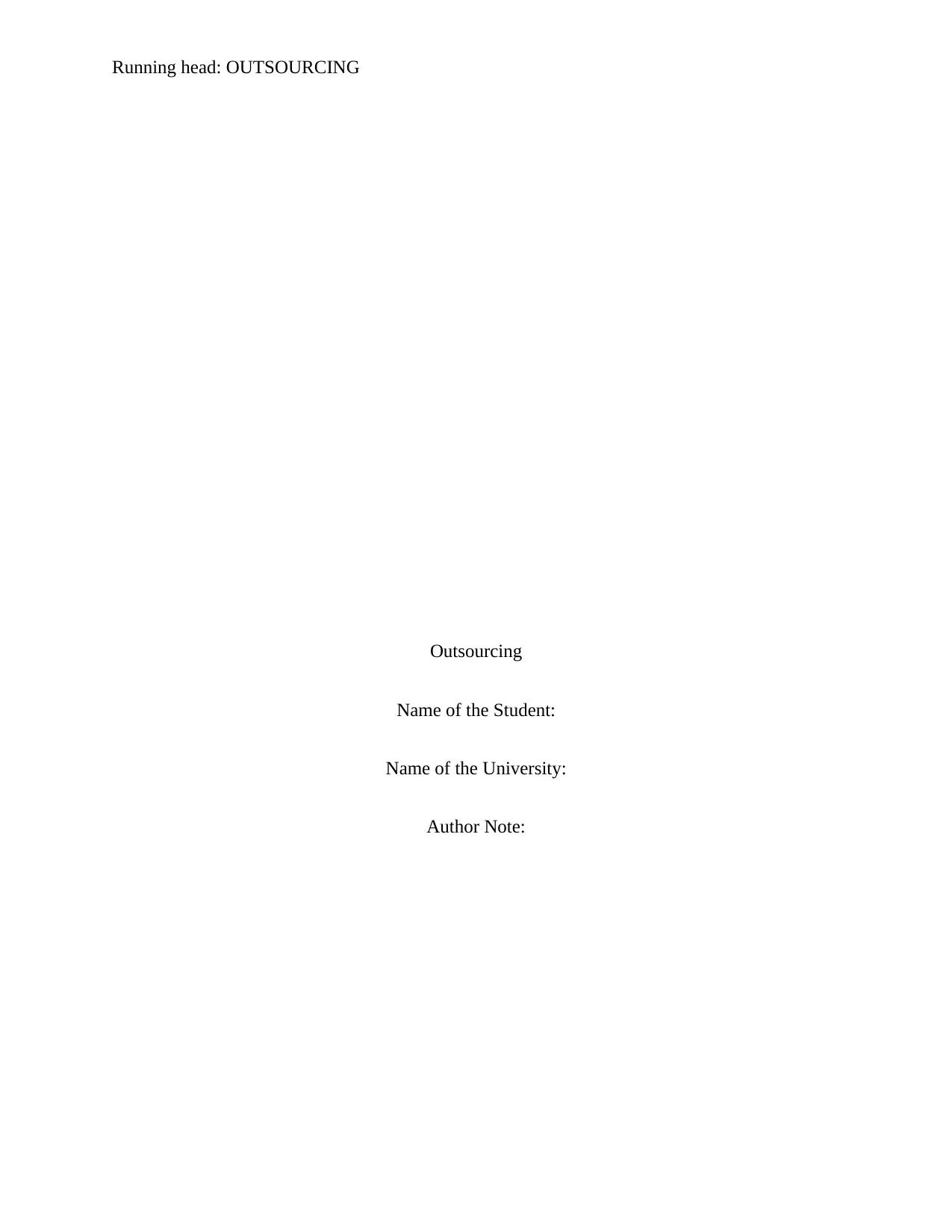
Running head: OUTSOURCING
Outsourcing
Name of the Student:
Name of the University:
Author Note:
Outsourcing
Name of the Student:
Name of the University:
Author Note:
Paraphrase This Document
Need a fresh take? Get an instant paraphrase of this document with our AI Paraphraser
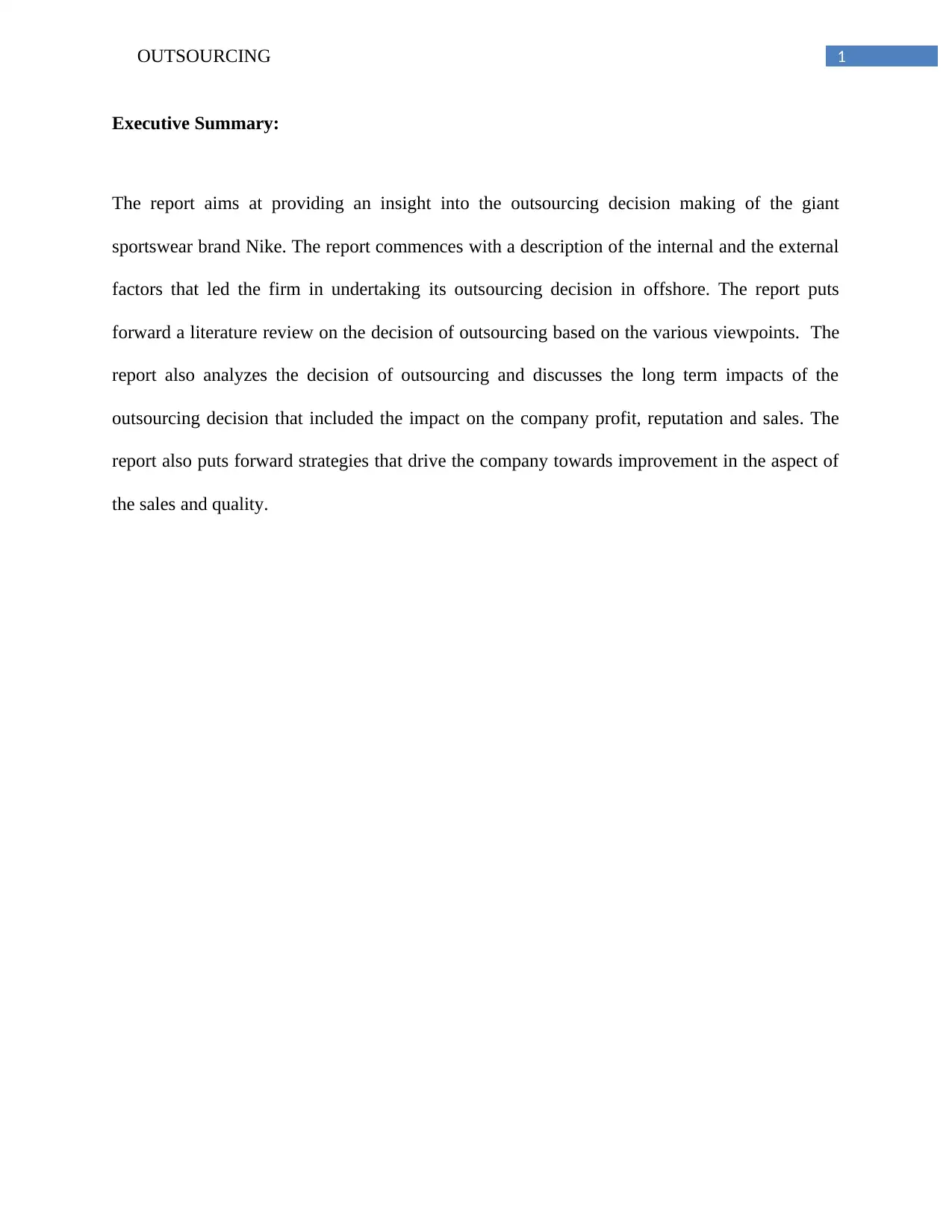
1OUTSOURCING
Executive Summary:
The report aims at providing an insight into the outsourcing decision making of the giant
sportswear brand Nike. The report commences with a description of the internal and the external
factors that led the firm in undertaking its outsourcing decision in offshore. The report puts
forward a literature review on the decision of outsourcing based on the various viewpoints. The
report also analyzes the decision of outsourcing and discusses the long term impacts of the
outsourcing decision that included the impact on the company profit, reputation and sales. The
report also puts forward strategies that drive the company towards improvement in the aspect of
the sales and quality.
Executive Summary:
The report aims at providing an insight into the outsourcing decision making of the giant
sportswear brand Nike. The report commences with a description of the internal and the external
factors that led the firm in undertaking its outsourcing decision in offshore. The report puts
forward a literature review on the decision of outsourcing based on the various viewpoints. The
report also analyzes the decision of outsourcing and discusses the long term impacts of the
outsourcing decision that included the impact on the company profit, reputation and sales. The
report also puts forward strategies that drive the company towards improvement in the aspect of
the sales and quality.
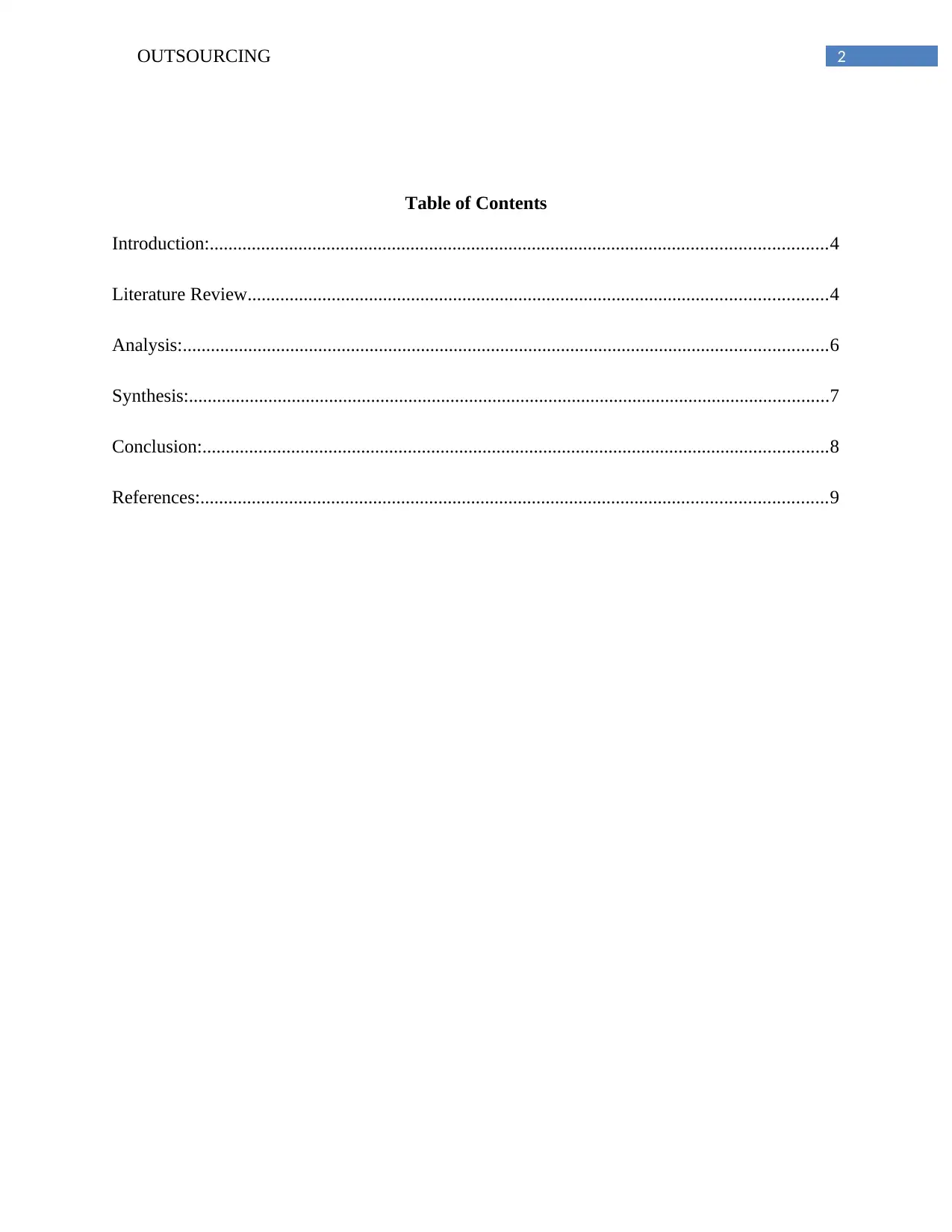
2OUTSOURCING
Table of Contents
Introduction:....................................................................................................................................4
Literature Review............................................................................................................................4
Analysis:..........................................................................................................................................6
Synthesis:.........................................................................................................................................7
Conclusion:......................................................................................................................................8
References:......................................................................................................................................9
Table of Contents
Introduction:....................................................................................................................................4
Literature Review............................................................................................................................4
Analysis:..........................................................................................................................................6
Synthesis:.........................................................................................................................................7
Conclusion:......................................................................................................................................8
References:......................................................................................................................................9
⊘ This is a preview!⊘
Do you want full access?
Subscribe today to unlock all pages.

Trusted by 1+ million students worldwide
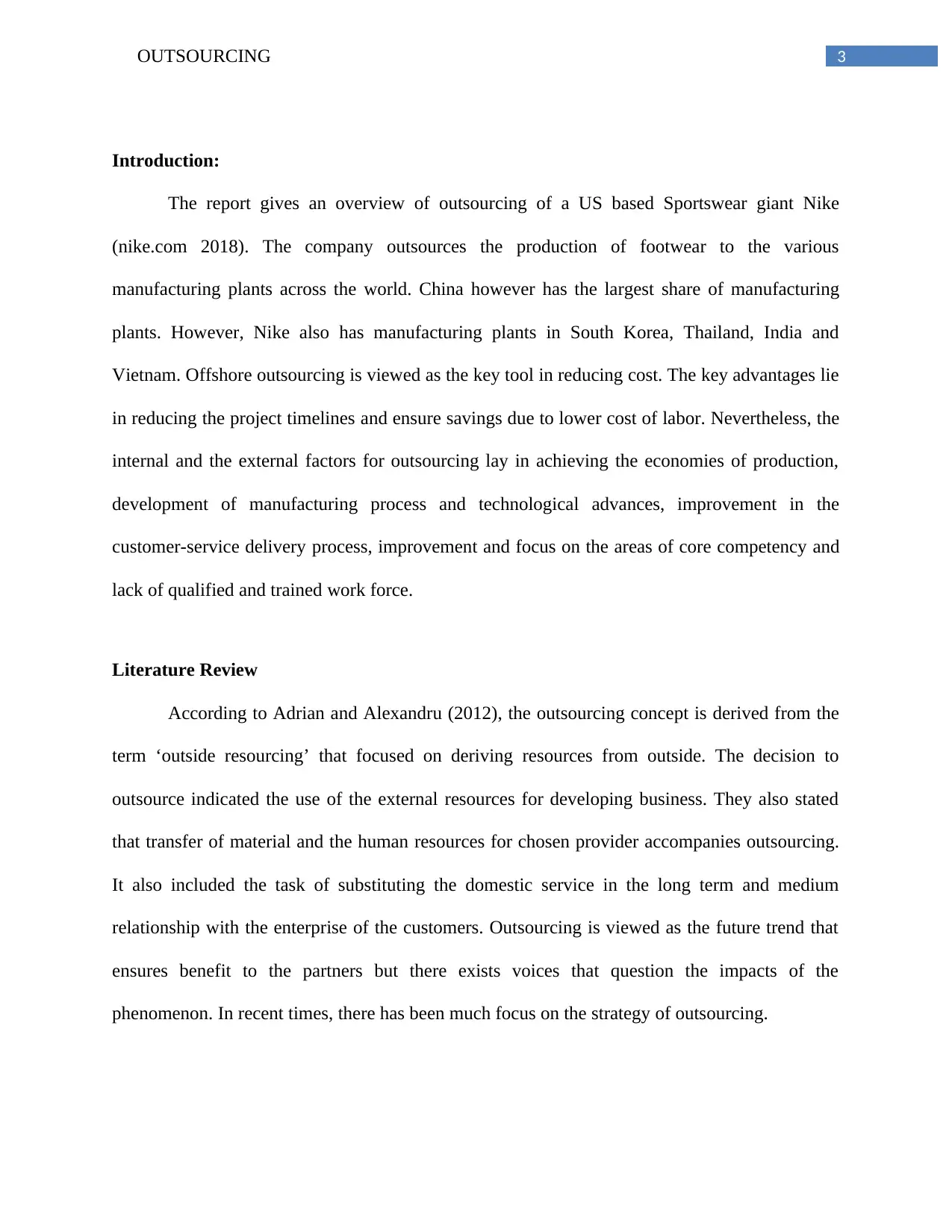
3OUTSOURCING
Introduction:
The report gives an overview of outsourcing of a US based Sportswear giant Nike
(nike.com 2018). The company outsources the production of footwear to the various
manufacturing plants across the world. China however has the largest share of manufacturing
plants. However, Nike also has manufacturing plants in South Korea, Thailand, India and
Vietnam. Offshore outsourcing is viewed as the key tool in reducing cost. The key advantages lie
in reducing the project timelines and ensure savings due to lower cost of labor. Nevertheless, the
internal and the external factors for outsourcing lay in achieving the economies of production,
development of manufacturing process and technological advances, improvement in the
customer-service delivery process, improvement and focus on the areas of core competency and
lack of qualified and trained work force.
Literature Review
According to Adrian and Alexandru (2012), the outsourcing concept is derived from the
term ‘outside resourcing’ that focused on deriving resources from outside. The decision to
outsource indicated the use of the external resources for developing business. They also stated
that transfer of material and the human resources for chosen provider accompanies outsourcing.
It also included the task of substituting the domestic service in the long term and medium
relationship with the enterprise of the customers. Outsourcing is viewed as the future trend that
ensures benefit to the partners but there exists voices that question the impacts of the
phenomenon. In recent times, there has been much focus on the strategy of outsourcing.
Introduction:
The report gives an overview of outsourcing of a US based Sportswear giant Nike
(nike.com 2018). The company outsources the production of footwear to the various
manufacturing plants across the world. China however has the largest share of manufacturing
plants. However, Nike also has manufacturing plants in South Korea, Thailand, India and
Vietnam. Offshore outsourcing is viewed as the key tool in reducing cost. The key advantages lie
in reducing the project timelines and ensure savings due to lower cost of labor. Nevertheless, the
internal and the external factors for outsourcing lay in achieving the economies of production,
development of manufacturing process and technological advances, improvement in the
customer-service delivery process, improvement and focus on the areas of core competency and
lack of qualified and trained work force.
Literature Review
According to Adrian and Alexandru (2012), the outsourcing concept is derived from the
term ‘outside resourcing’ that focused on deriving resources from outside. The decision to
outsource indicated the use of the external resources for developing business. They also stated
that transfer of material and the human resources for chosen provider accompanies outsourcing.
It also included the task of substituting the domestic service in the long term and medium
relationship with the enterprise of the customers. Outsourcing is viewed as the future trend that
ensures benefit to the partners but there exists voices that question the impacts of the
phenomenon. In recent times, there has been much focus on the strategy of outsourcing.
Paraphrase This Document
Need a fresh take? Get an instant paraphrase of this document with our AI Paraphraser
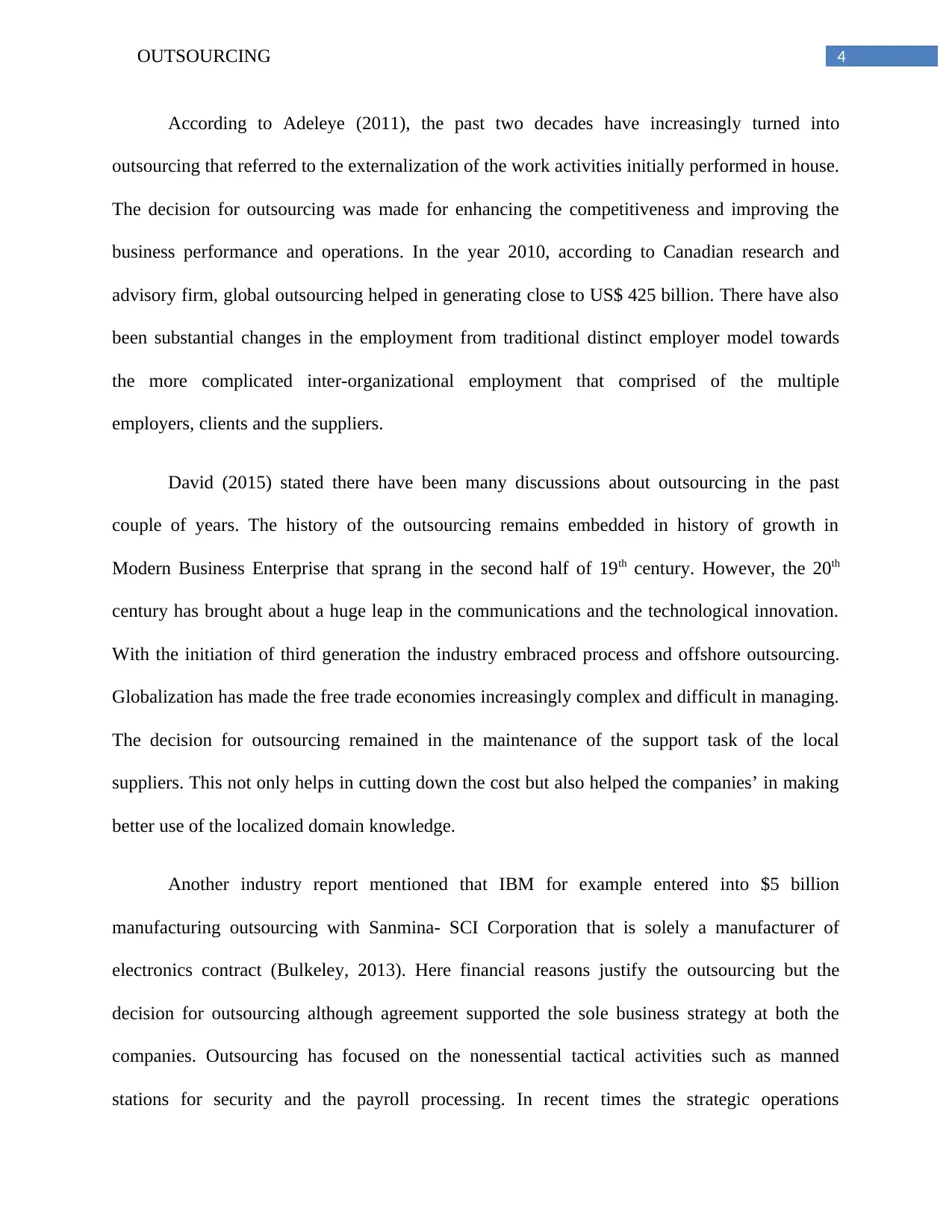
4OUTSOURCING
According to Adeleye (2011), the past two decades have increasingly turned into
outsourcing that referred to the externalization of the work activities initially performed in house.
The decision for outsourcing was made for enhancing the competitiveness and improving the
business performance and operations. In the year 2010, according to Canadian research and
advisory firm, global outsourcing helped in generating close to US$ 425 billion. There have also
been substantial changes in the employment from traditional distinct employer model towards
the more complicated inter-organizational employment that comprised of the multiple
employers, clients and the suppliers.
David (2015) stated there have been many discussions about outsourcing in the past
couple of years. The history of the outsourcing remains embedded in history of growth in
Modern Business Enterprise that sprang in the second half of 19th century. However, the 20th
century has brought about a huge leap in the communications and the technological innovation.
With the initiation of third generation the industry embraced process and offshore outsourcing.
Globalization has made the free trade economies increasingly complex and difficult in managing.
The decision for outsourcing remained in the maintenance of the support task of the local
suppliers. This not only helps in cutting down the cost but also helped the companies’ in making
better use of the localized domain knowledge.
Another industry report mentioned that IBM for example entered into $5 billion
manufacturing outsourcing with Sanmina- SCI Corporation that is solely a manufacturer of
electronics contract (Bulkeley, 2013). Here financial reasons justify the outsourcing but the
decision for outsourcing although agreement supported the sole business strategy at both the
companies. Outsourcing has focused on the nonessential tactical activities such as manned
stations for security and the payroll processing. In recent times the strategic operations
According to Adeleye (2011), the past two decades have increasingly turned into
outsourcing that referred to the externalization of the work activities initially performed in house.
The decision for outsourcing was made for enhancing the competitiveness and improving the
business performance and operations. In the year 2010, according to Canadian research and
advisory firm, global outsourcing helped in generating close to US$ 425 billion. There have also
been substantial changes in the employment from traditional distinct employer model towards
the more complicated inter-organizational employment that comprised of the multiple
employers, clients and the suppliers.
David (2015) stated there have been many discussions about outsourcing in the past
couple of years. The history of the outsourcing remains embedded in history of growth in
Modern Business Enterprise that sprang in the second half of 19th century. However, the 20th
century has brought about a huge leap in the communications and the technological innovation.
With the initiation of third generation the industry embraced process and offshore outsourcing.
Globalization has made the free trade economies increasingly complex and difficult in managing.
The decision for outsourcing remained in the maintenance of the support task of the local
suppliers. This not only helps in cutting down the cost but also helped the companies’ in making
better use of the localized domain knowledge.
Another industry report mentioned that IBM for example entered into $5 billion
manufacturing outsourcing with Sanmina- SCI Corporation that is solely a manufacturer of
electronics contract (Bulkeley, 2013). Here financial reasons justify the outsourcing but the
decision for outsourcing although agreement supported the sole business strategy at both the
companies. Outsourcing has focused on the nonessential tactical activities such as manned
stations for security and the payroll processing. In recent times the strategic operations
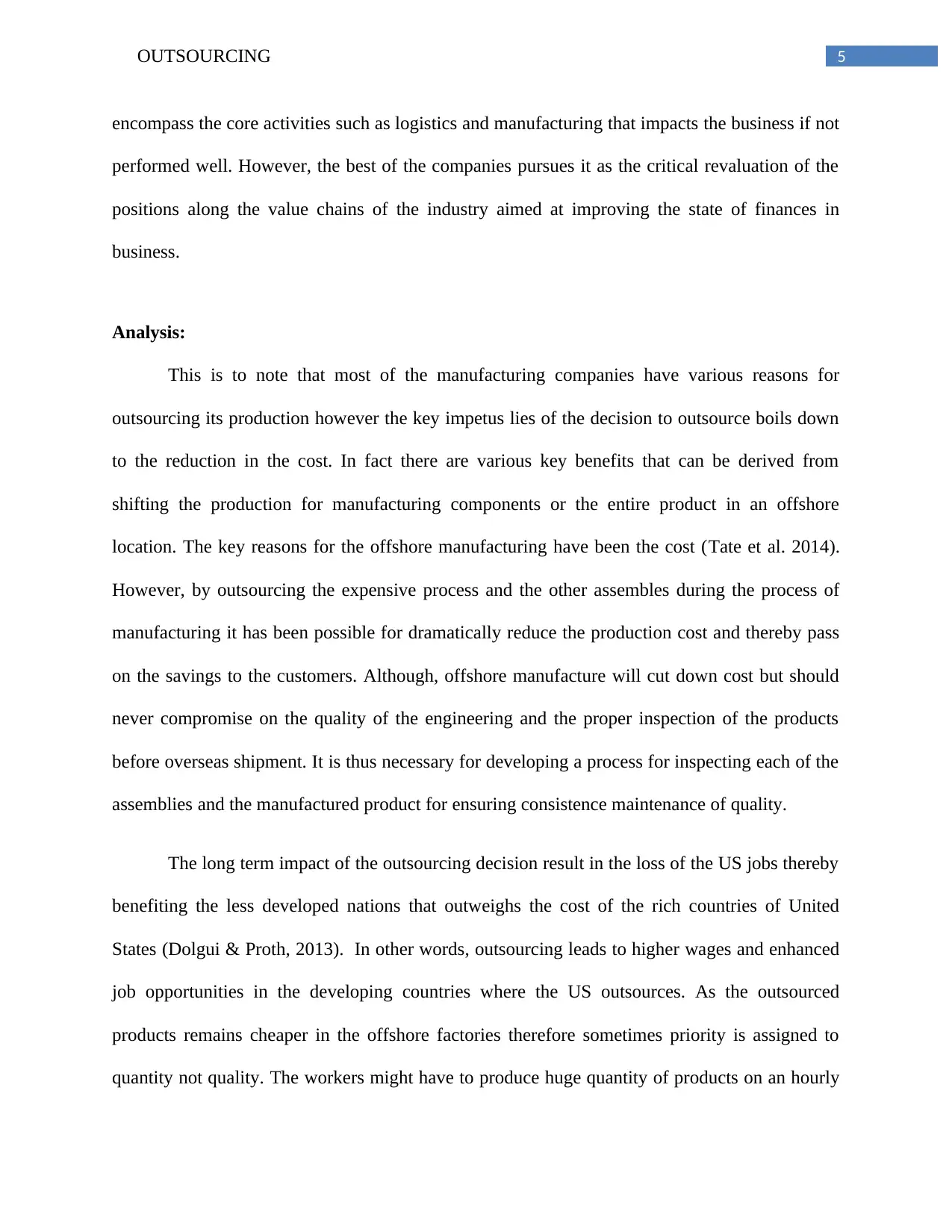
5OUTSOURCING
encompass the core activities such as logistics and manufacturing that impacts the business if not
performed well. However, the best of the companies pursues it as the critical revaluation of the
positions along the value chains of the industry aimed at improving the state of finances in
business.
Analysis:
This is to note that most of the manufacturing companies have various reasons for
outsourcing its production however the key impetus lies of the decision to outsource boils down
to the reduction in the cost. In fact there are various key benefits that can be derived from
shifting the production for manufacturing components or the entire product in an offshore
location. The key reasons for the offshore manufacturing have been the cost (Tate et al. 2014).
However, by outsourcing the expensive process and the other assembles during the process of
manufacturing it has been possible for dramatically reduce the production cost and thereby pass
on the savings to the customers. Although, offshore manufacture will cut down cost but should
never compromise on the quality of the engineering and the proper inspection of the products
before overseas shipment. It is thus necessary for developing a process for inspecting each of the
assemblies and the manufactured product for ensuring consistence maintenance of quality.
The long term impact of the outsourcing decision result in the loss of the US jobs thereby
benefiting the less developed nations that outweighs the cost of the rich countries of United
States (Dolgui & Proth, 2013). In other words, outsourcing leads to higher wages and enhanced
job opportunities in the developing countries where the US outsources. As the outsourced
products remains cheaper in the offshore factories therefore sometimes priority is assigned to
quantity not quality. The workers might have to produce huge quantity of products on an hourly
encompass the core activities such as logistics and manufacturing that impacts the business if not
performed well. However, the best of the companies pursues it as the critical revaluation of the
positions along the value chains of the industry aimed at improving the state of finances in
business.
Analysis:
This is to note that most of the manufacturing companies have various reasons for
outsourcing its production however the key impetus lies of the decision to outsource boils down
to the reduction in the cost. In fact there are various key benefits that can be derived from
shifting the production for manufacturing components or the entire product in an offshore
location. The key reasons for the offshore manufacturing have been the cost (Tate et al. 2014).
However, by outsourcing the expensive process and the other assembles during the process of
manufacturing it has been possible for dramatically reduce the production cost and thereby pass
on the savings to the customers. Although, offshore manufacture will cut down cost but should
never compromise on the quality of the engineering and the proper inspection of the products
before overseas shipment. It is thus necessary for developing a process for inspecting each of the
assemblies and the manufactured product for ensuring consistence maintenance of quality.
The long term impact of the outsourcing decision result in the loss of the US jobs thereby
benefiting the less developed nations that outweighs the cost of the rich countries of United
States (Dolgui & Proth, 2013). In other words, outsourcing leads to higher wages and enhanced
job opportunities in the developing countries where the US outsources. As the outsourced
products remains cheaper in the offshore factories therefore sometimes priority is assigned to
quantity not quality. The workers might have to produce huge quantity of products on an hourly
⊘ This is a preview!⊘
Do you want full access?
Subscribe today to unlock all pages.

Trusted by 1+ million students worldwide
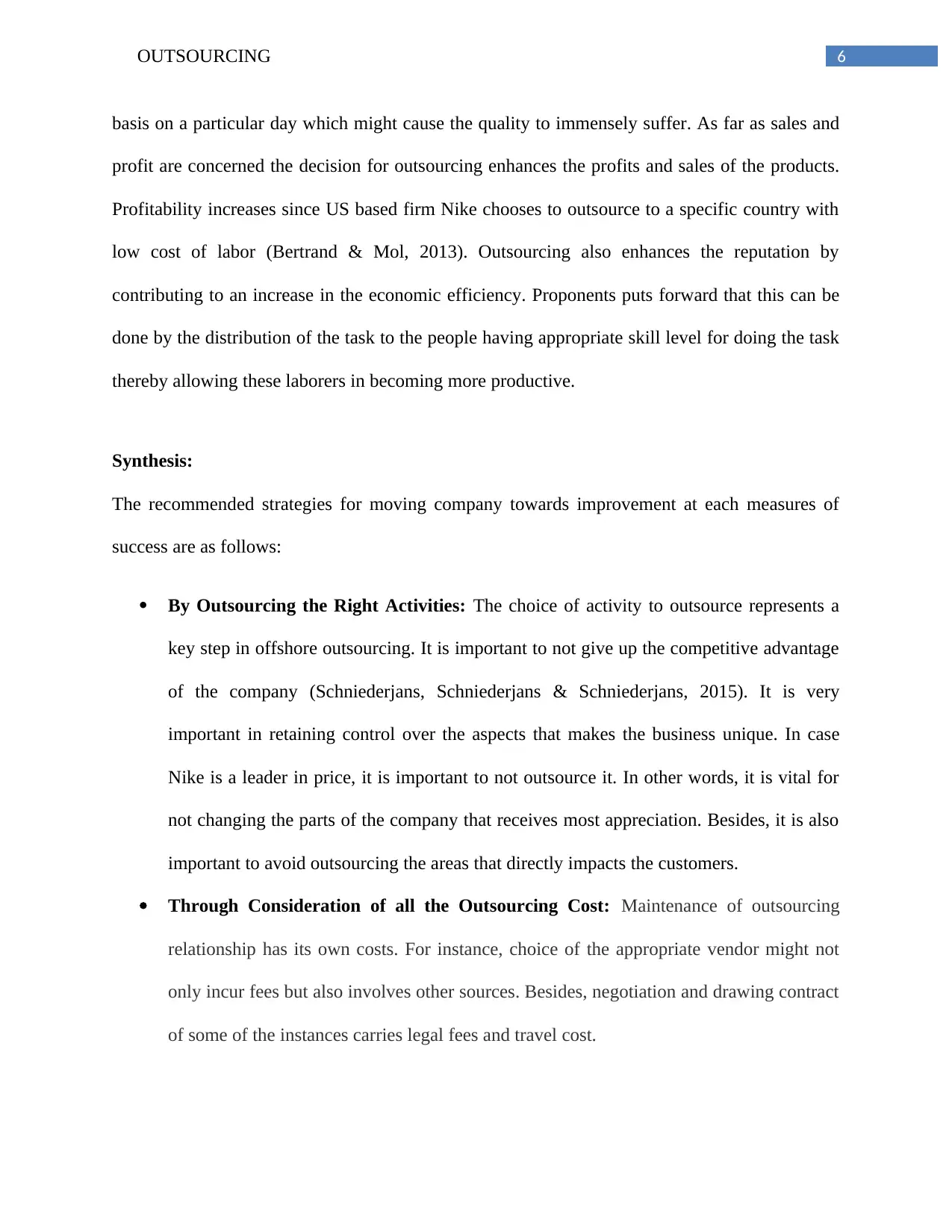
6OUTSOURCING
basis on a particular day which might cause the quality to immensely suffer. As far as sales and
profit are concerned the decision for outsourcing enhances the profits and sales of the products.
Profitability increases since US based firm Nike chooses to outsource to a specific country with
low cost of labor (Bertrand & Mol, 2013). Outsourcing also enhances the reputation by
contributing to an increase in the economic efficiency. Proponents puts forward that this can be
done by the distribution of the task to the people having appropriate skill level for doing the task
thereby allowing these laborers in becoming more productive.
Synthesis:
The recommended strategies for moving company towards improvement at each measures of
success are as follows:
By Outsourcing the Right Activities: The choice of activity to outsource represents a
key step in offshore outsourcing. It is important to not give up the competitive advantage
of the company (Schniederjans, Schniederjans & Schniederjans, 2015). It is very
important in retaining control over the aspects that makes the business unique. In case
Nike is a leader in price, it is important to not outsource it. In other words, it is vital for
not changing the parts of the company that receives most appreciation. Besides, it is also
important to avoid outsourcing the areas that directly impacts the customers.
Through Consideration of all the Outsourcing Cost: Maintenance of outsourcing
relationship has its own costs. For instance, choice of the appropriate vendor might not
only incur fees but also involves other sources. Besides, negotiation and drawing contract
of some of the instances carries legal fees and travel cost.
basis on a particular day which might cause the quality to immensely suffer. As far as sales and
profit are concerned the decision for outsourcing enhances the profits and sales of the products.
Profitability increases since US based firm Nike chooses to outsource to a specific country with
low cost of labor (Bertrand & Mol, 2013). Outsourcing also enhances the reputation by
contributing to an increase in the economic efficiency. Proponents puts forward that this can be
done by the distribution of the task to the people having appropriate skill level for doing the task
thereby allowing these laborers in becoming more productive.
Synthesis:
The recommended strategies for moving company towards improvement at each measures of
success are as follows:
By Outsourcing the Right Activities: The choice of activity to outsource represents a
key step in offshore outsourcing. It is important to not give up the competitive advantage
of the company (Schniederjans, Schniederjans & Schniederjans, 2015). It is very
important in retaining control over the aspects that makes the business unique. In case
Nike is a leader in price, it is important to not outsource it. In other words, it is vital for
not changing the parts of the company that receives most appreciation. Besides, it is also
important to avoid outsourcing the areas that directly impacts the customers.
Through Consideration of all the Outsourcing Cost: Maintenance of outsourcing
relationship has its own costs. For instance, choice of the appropriate vendor might not
only incur fees but also involves other sources. Besides, negotiation and drawing contract
of some of the instances carries legal fees and travel cost.
Paraphrase This Document
Need a fresh take? Get an instant paraphrase of this document with our AI Paraphraser
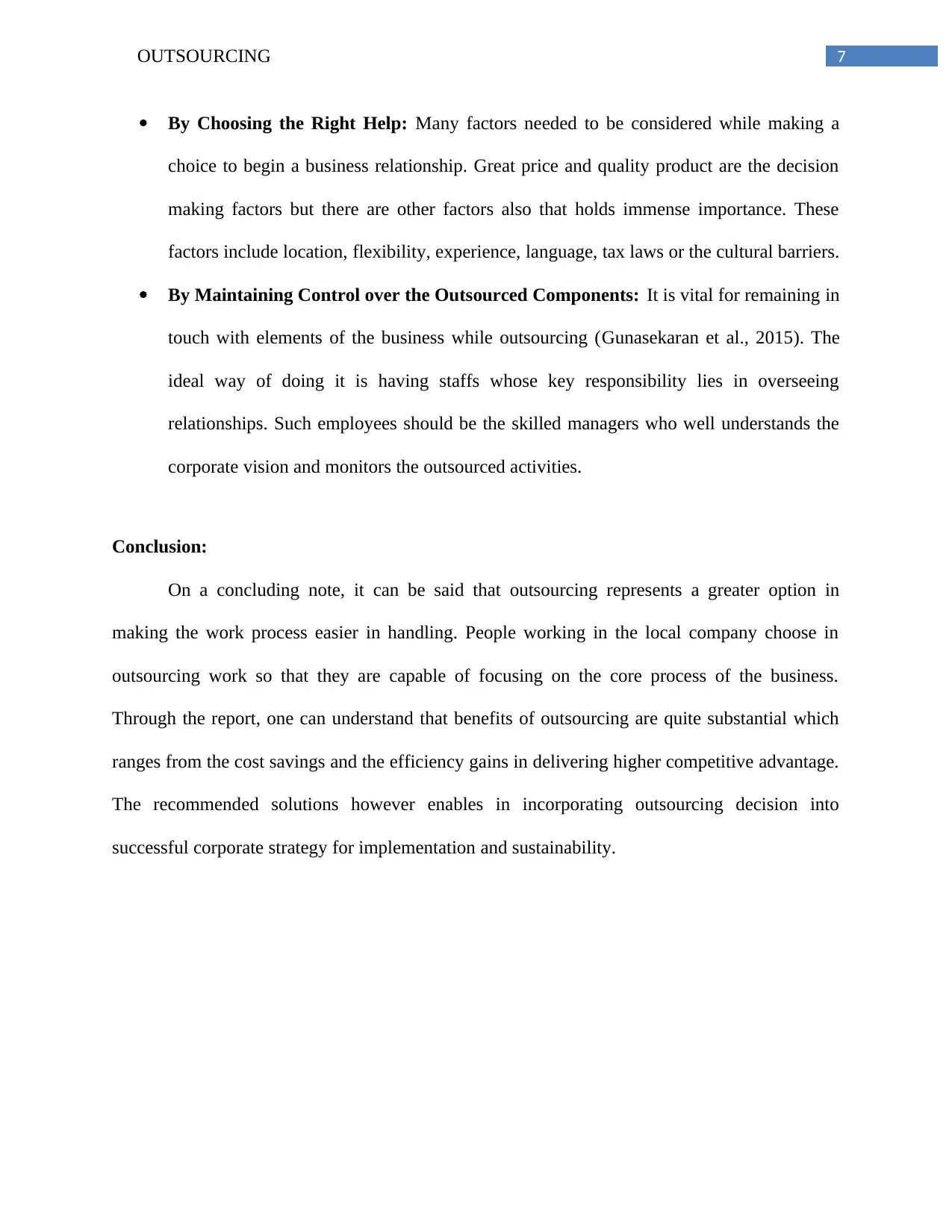
7OUTSOURCING
By Choosing the Right Help: Many factors needed to be considered while making a
choice to begin a business relationship. Great price and quality product are the decision
making factors but there are other factors also that holds immense importance. These
factors include location, flexibility, experience, language, tax laws or the cultural barriers.
By Maintaining Control over the Outsourced Components: It is vital for remaining in
touch with elements of the business while outsourcing (Gunasekaran et al., 2015). The
ideal way of doing it is having staffs whose key responsibility lies in overseeing
relationships. Such employees should be the skilled managers who well understands the
corporate vision and monitors the outsourced activities.
Conclusion:
On a concluding note, it can be said that outsourcing represents a greater option in
making the work process easier in handling. People working in the local company choose in
outsourcing work so that they are capable of focusing on the core process of the business.
Through the report, one can understand that benefits of outsourcing are quite substantial which
ranges from the cost savings and the efficiency gains in delivering higher competitive advantage.
The recommended solutions however enables in incorporating outsourcing decision into
successful corporate strategy for implementation and sustainability.
By Choosing the Right Help: Many factors needed to be considered while making a
choice to begin a business relationship. Great price and quality product are the decision
making factors but there are other factors also that holds immense importance. These
factors include location, flexibility, experience, language, tax laws or the cultural barriers.
By Maintaining Control over the Outsourced Components: It is vital for remaining in
touch with elements of the business while outsourcing (Gunasekaran et al., 2015). The
ideal way of doing it is having staffs whose key responsibility lies in overseeing
relationships. Such employees should be the skilled managers who well understands the
corporate vision and monitors the outsourced activities.
Conclusion:
On a concluding note, it can be said that outsourcing represents a greater option in
making the work process easier in handling. People working in the local company choose in
outsourcing work so that they are capable of focusing on the core process of the business.
Through the report, one can understand that benefits of outsourcing are quite substantial which
ranges from the cost savings and the efficiency gains in delivering higher competitive advantage.
The recommended solutions however enables in incorporating outsourcing decision into
successful corporate strategy for implementation and sustainability.
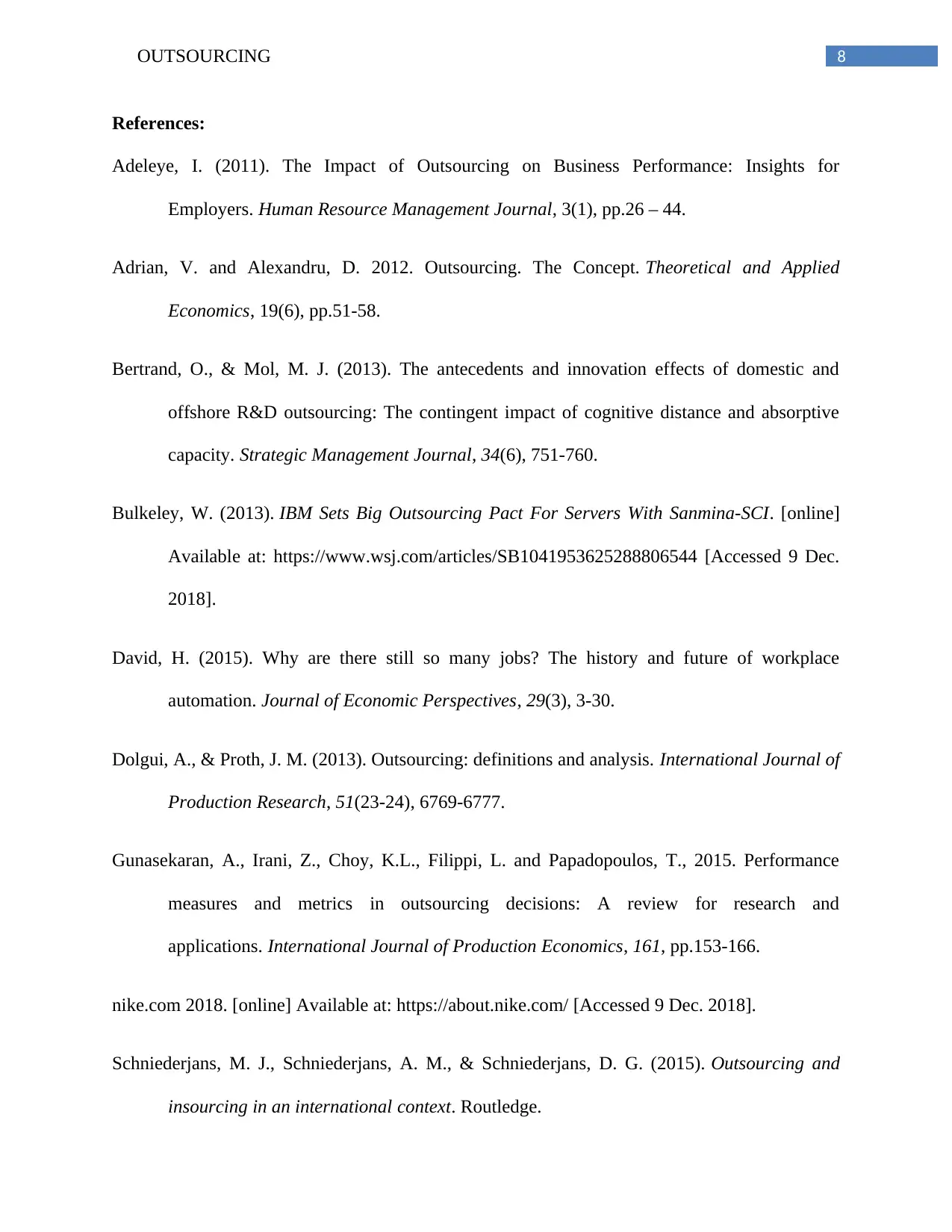
8OUTSOURCING
References:
Adeleye, I. (2011). The Impact of Outsourcing on Business Performance: Insights for
Employers. Human Resource Management Journal, 3(1), pp.26 – 44.
Adrian, V. and Alexandru, D. 2012. Outsourcing. The Concept. Theoretical and Applied
Economics, 19(6), pp.51-58.
Bertrand, O., & Mol, M. J. (2013). The antecedents and innovation effects of domestic and
offshore R&D outsourcing: The contingent impact of cognitive distance and absorptive
capacity. Strategic Management Journal, 34(6), 751-760.
Bulkeley, W. (2013). IBM Sets Big Outsourcing Pact For Servers With Sanmina-SCI. [online]
Available at: https://www.wsj.com/articles/SB1041953625288806544 [Accessed 9 Dec.
2018].
David, H. (2015). Why are there still so many jobs? The history and future of workplace
automation. Journal of Economic Perspectives, 29(3), 3-30.
Dolgui, A., & Proth, J. M. (2013). Outsourcing: definitions and analysis. International Journal of
Production Research, 51(23-24), 6769-6777.
Gunasekaran, A., Irani, Z., Choy, K.L., Filippi, L. and Papadopoulos, T., 2015. Performance
measures and metrics in outsourcing decisions: A review for research and
applications. International Journal of Production Economics, 161, pp.153-166.
nike.com 2018. [online] Available at: https://about.nike.com/ [Accessed 9 Dec. 2018].
Schniederjans, M. J., Schniederjans, A. M., & Schniederjans, D. G. (2015). Outsourcing and
insourcing in an international context. Routledge.
References:
Adeleye, I. (2011). The Impact of Outsourcing on Business Performance: Insights for
Employers. Human Resource Management Journal, 3(1), pp.26 – 44.
Adrian, V. and Alexandru, D. 2012. Outsourcing. The Concept. Theoretical and Applied
Economics, 19(6), pp.51-58.
Bertrand, O., & Mol, M. J. (2013). The antecedents and innovation effects of domestic and
offshore R&D outsourcing: The contingent impact of cognitive distance and absorptive
capacity. Strategic Management Journal, 34(6), 751-760.
Bulkeley, W. (2013). IBM Sets Big Outsourcing Pact For Servers With Sanmina-SCI. [online]
Available at: https://www.wsj.com/articles/SB1041953625288806544 [Accessed 9 Dec.
2018].
David, H. (2015). Why are there still so many jobs? The history and future of workplace
automation. Journal of Economic Perspectives, 29(3), 3-30.
Dolgui, A., & Proth, J. M. (2013). Outsourcing: definitions and analysis. International Journal of
Production Research, 51(23-24), 6769-6777.
Gunasekaran, A., Irani, Z., Choy, K.L., Filippi, L. and Papadopoulos, T., 2015. Performance
measures and metrics in outsourcing decisions: A review for research and
applications. International Journal of Production Economics, 161, pp.153-166.
nike.com 2018. [online] Available at: https://about.nike.com/ [Accessed 9 Dec. 2018].
Schniederjans, M. J., Schniederjans, A. M., & Schniederjans, D. G. (2015). Outsourcing and
insourcing in an international context. Routledge.
⊘ This is a preview!⊘
Do you want full access?
Subscribe today to unlock all pages.

Trusted by 1+ million students worldwide
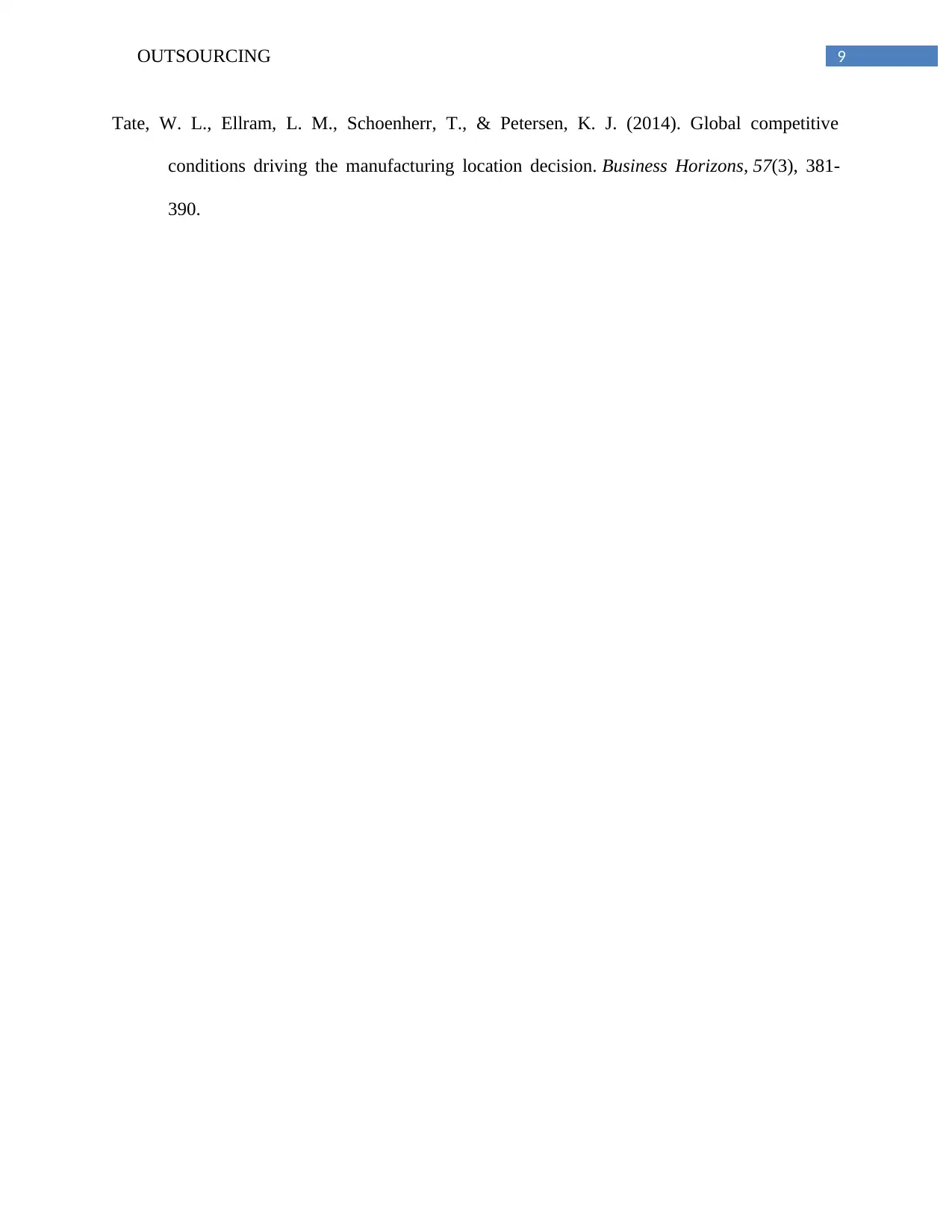
9OUTSOURCING
Tate, W. L., Ellram, L. M., Schoenherr, T., & Petersen, K. J. (2014). Global competitive
conditions driving the manufacturing location decision. Business Horizons, 57(3), 381-
390.
Tate, W. L., Ellram, L. M., Schoenherr, T., & Petersen, K. J. (2014). Global competitive
conditions driving the manufacturing location decision. Business Horizons, 57(3), 381-
390.
1 out of 10
Related Documents
Your All-in-One AI-Powered Toolkit for Academic Success.
+13062052269
info@desklib.com
Available 24*7 on WhatsApp / Email
![[object Object]](/_next/static/media/star-bottom.7253800d.svg)
Unlock your academic potential
Copyright © 2020–2025 A2Z Services. All Rights Reserved. Developed and managed by ZUCOL.




